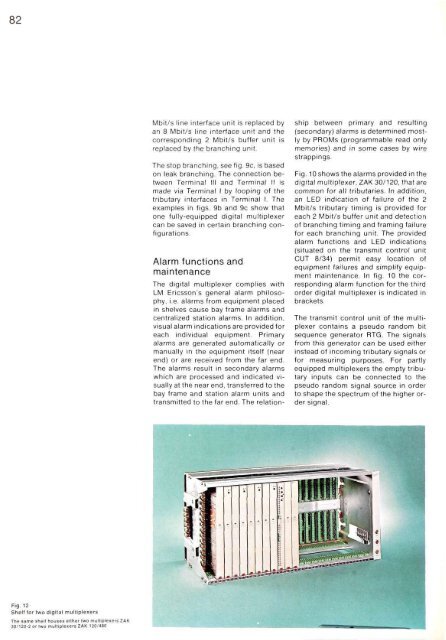saudi arabia-the largest telephone project in the world a new ...
saudi arabia-the largest telephone project in the world a new ...
saudi arabia-the largest telephone project in the world a new ...
- No tags were found...
Create successful ePaper yourself
Turn your PDF publications into a flip-book with our unique Google optimized e-Paper software.
82Mbit/s l<strong>in</strong>e <strong>in</strong>terface unit is replaced byan 8 Mbit/s l<strong>in</strong>e <strong>in</strong>terface unit and <strong>the</strong>correspond<strong>in</strong>g 2 Mbit/s buffer unit isreplaced by <strong>the</strong> branch<strong>in</strong>g unit.The stop branch<strong>in</strong>g, see fig. 9c, is basedon leak branch<strong>in</strong>g. The connection betweenTerm<strong>in</strong>al III and Term<strong>in</strong>al II ismade via Term<strong>in</strong>al I by loop<strong>in</strong>g of <strong>the</strong>tributary <strong>in</strong>terfaces <strong>in</strong> Term<strong>in</strong>al I. Theexamples <strong>in</strong> figs. 9b and 9c show thatone fully-equipped digital multiplexercan be saved <strong>in</strong> certa<strong>in</strong> branch<strong>in</strong>g configurations.Alarm functions andma<strong>in</strong>tenanceThe digital multiplexer complies withLM Ericsson's general alarm philosophy,i.e. alarms from equipment placed<strong>in</strong> shelves cause bay frame alarms andcentralized station alarms. In addition,visual alarm <strong>in</strong>dications are provided foreach <strong>in</strong>dividual equipment. Primaryalarms are generated automatically ormanually <strong>in</strong> <strong>the</strong> equipment itself (nearend) or are received from <strong>the</strong> far end.The alarms result <strong>in</strong> secondary alarmswhich are processed and <strong>in</strong>dicated visuallyat <strong>the</strong> near end, transferred to <strong>the</strong>bay frame and station alarm units andtransmitted to <strong>the</strong> far end. The relationshipbetween primary and result<strong>in</strong>g(secondary) alarms is determ<strong>in</strong>ed mostlyby PROMs (programmable read onlymemories) and <strong>in</strong> some cases by wirestrapp<strong>in</strong>gs.Fig. 10 shows <strong>the</strong> alarms provided <strong>in</strong> <strong>the</strong>digital multiplexer, ZAK 30/120, that arecommon for all tributaries. In addition,an LED <strong>in</strong>dication of failure of <strong>the</strong> 2Mbit/s tributary tim<strong>in</strong>g is provided foreach 2 Mbit/s buffer unit and detectionof branch<strong>in</strong>g tim<strong>in</strong>g and fram<strong>in</strong>g failurefor each branch<strong>in</strong>g unit. The providedalarm functions and LED <strong>in</strong>dications(situated on <strong>the</strong> transmit control unitCUT 8/34) permit easy location ofequipment failures and simplify equipmentma<strong>in</strong>tenance. In fig. 10 <strong>the</strong> correspond<strong>in</strong>galarm function for <strong>the</strong> thirdorder digital multiplexer is <strong>in</strong>dicated <strong>in</strong>brackets.The transmit control unit of <strong>the</strong> multiplexerconta<strong>in</strong>s a pseudo random bitsequence generator RTG. The signalsfrom this generator can be used ei<strong>the</strong>r<strong>in</strong>stead of <strong>in</strong>com<strong>in</strong>g tributary signals orfor measur<strong>in</strong>g purposes. For partlyequipped multiplexers <strong>the</strong> empty tributary<strong>in</strong>puts can be connected to <strong>the</strong>pseudo random signal source <strong>in</strong> orderto shape <strong>the</strong> spectrum of <strong>the</strong> higher ordersignal.Fig. 12Shelf for two digital multiplexersThe same shelf houses ei<strong>the</strong>r two multiplexers ZAK30/120-2 or two multiplexers ZAK 120/480















